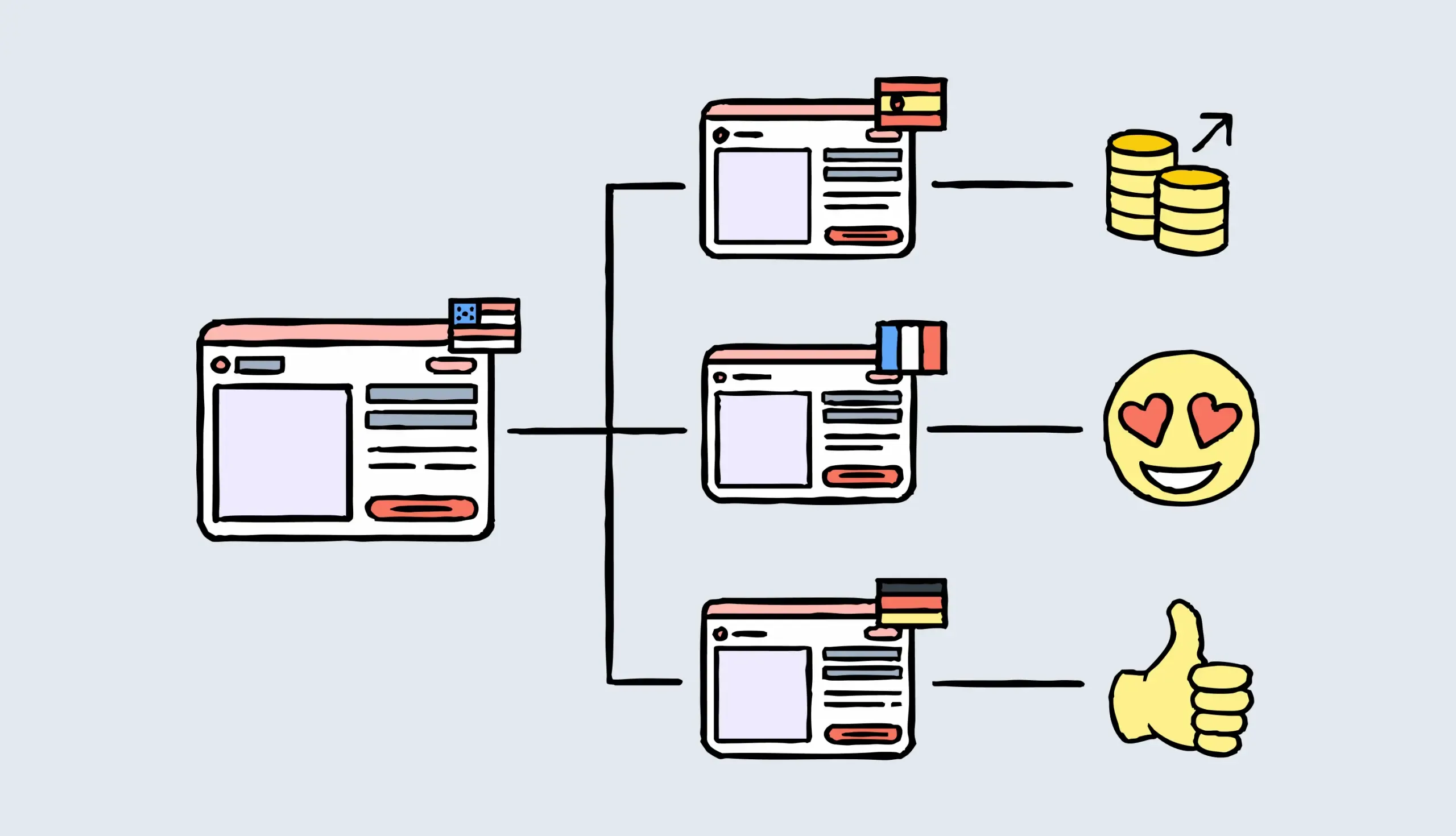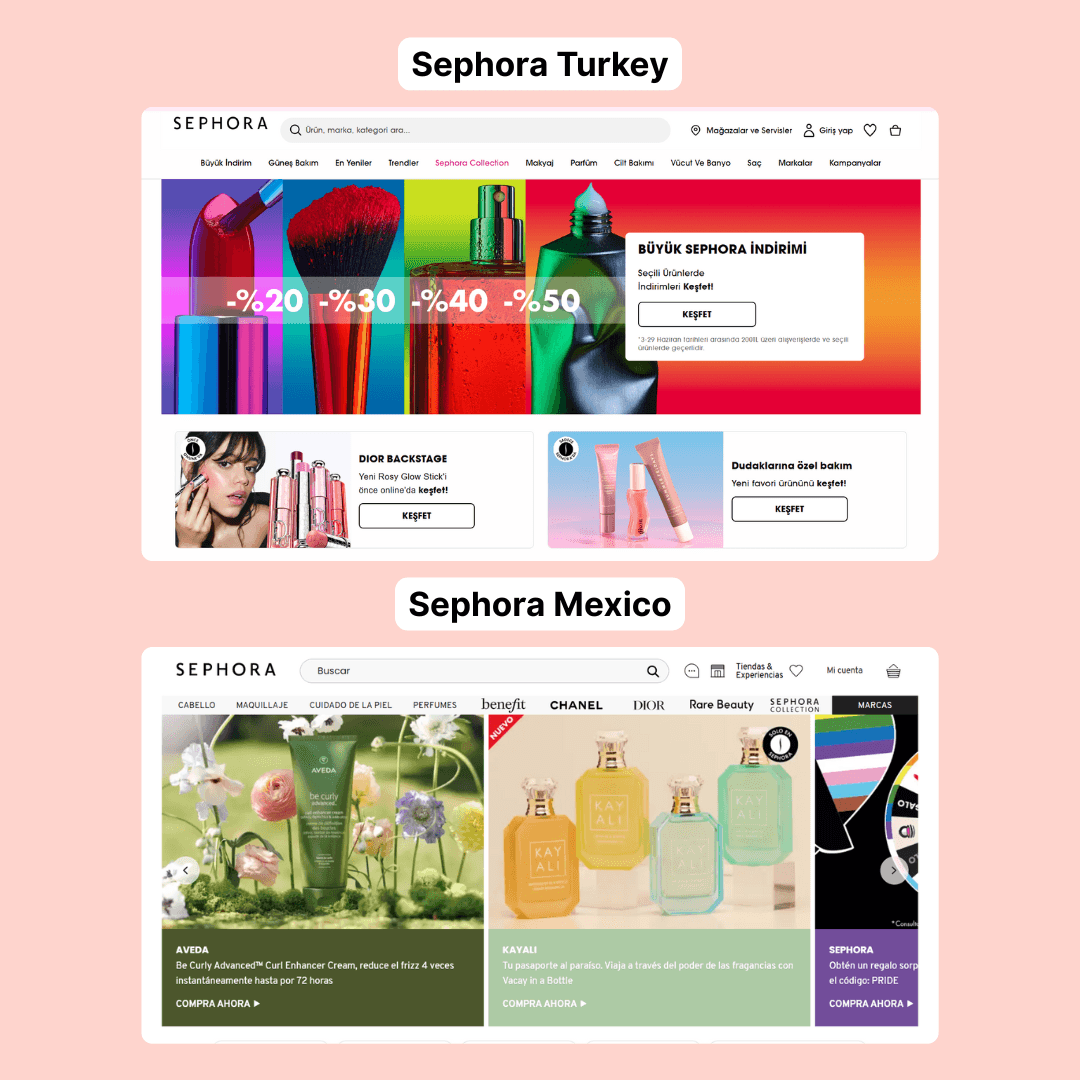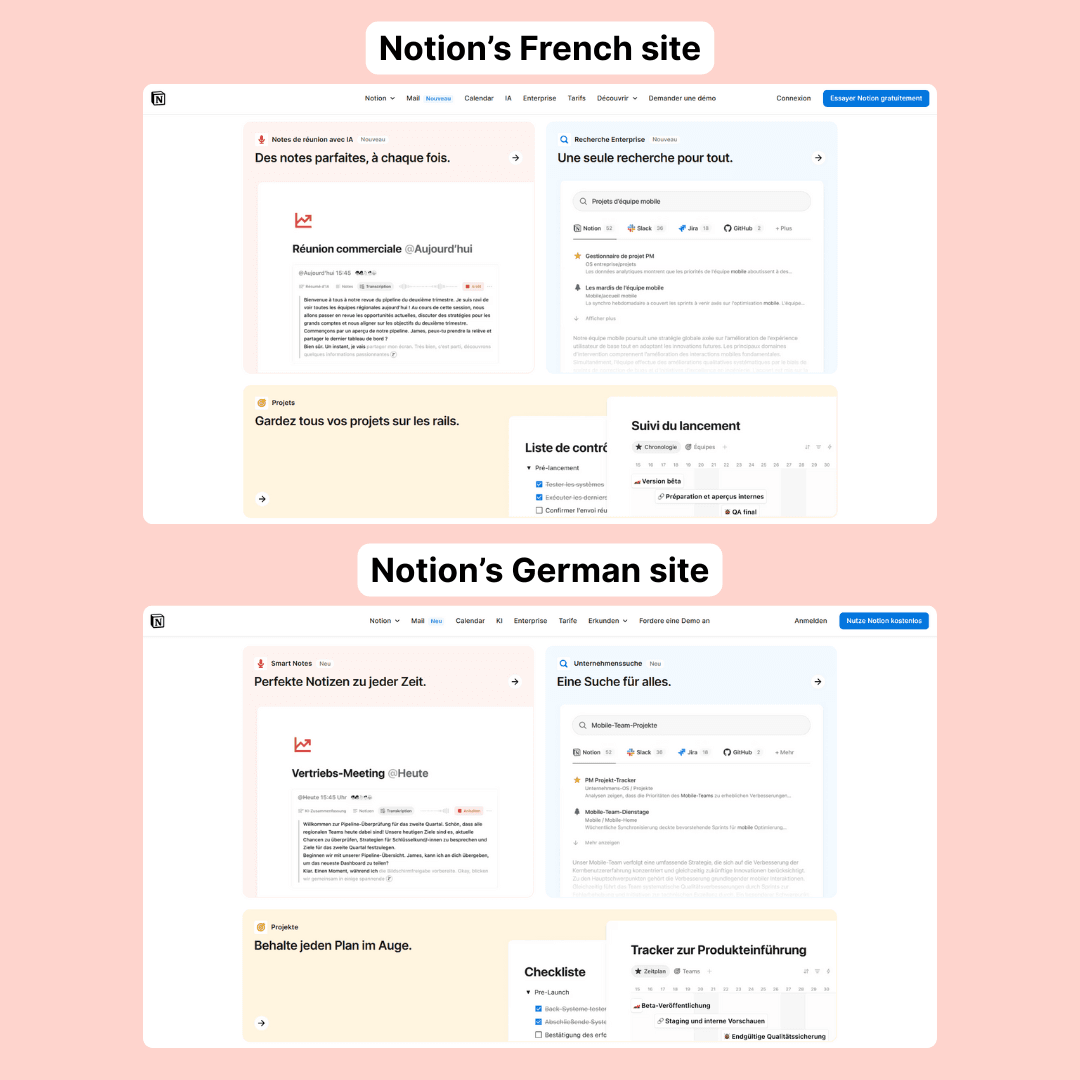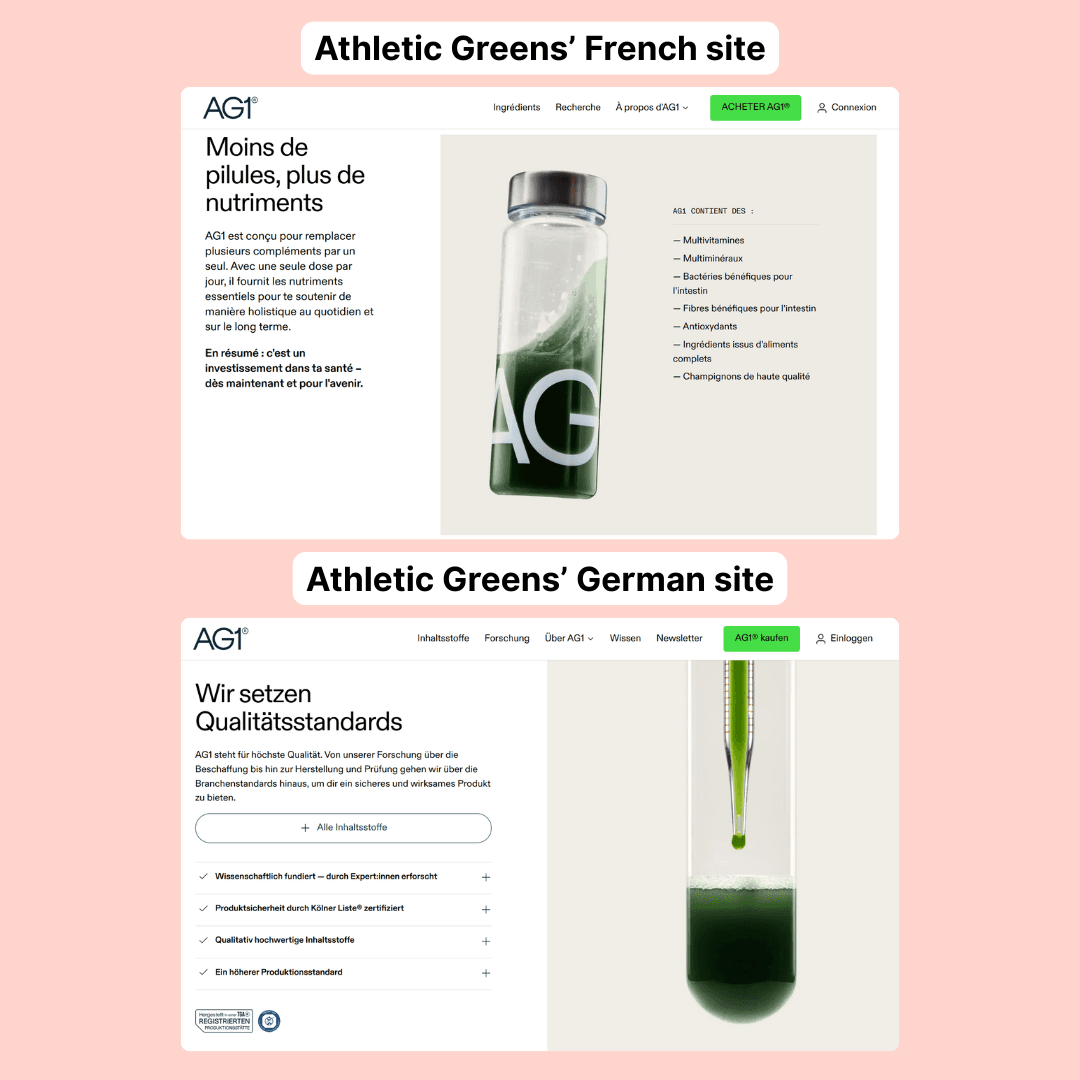8 Reasons Why Website Localization is Important (+ Examples)

Imagine walking into a store and asking a salesperson for help. But they start talking in a language you don’t understand.
You cluelessly try to gesture with your hands, speak slowly in English, and pray that they somehow understand you.
But nothing works, and you walk out of the store disappointed.
That’s a lot like what your potential customers feel when your business website isn’t localized for their market. They’re confused and frustrated, ultimately leaving your site without any purchases.
If you’re on the fence about localizing your website and whether it’ll actually move the needle for your business, we wrote this guide for you. We’ll make a case for why website localization matters and how it can drive long-term growth for your brand.
- What is website localization?
- Why website localization is important
- 1. Higher sales and increased revenue
- 2. Resonate with your audience
- 3. Deliver a familiar and frictionless user experience
- 4. Improve the buying journey
- 5. Enhance organic search visibility
- 6. Strengthen position against global competitors
- 7. Become culturally relevant to buyers
- 8. Boost your brand perception
- 3 website localization challenges to prepare for
- Set your website up for success across markets
What is website localization?
Website localization strategically modifies and rethinks different elements of your website—from messaging to design—to make your brand feel more native to a local market. It specifically focuses on adapting your site to align with the cultural, financial, and regulatory requirements of a local market.
This process can involve:
- Minor changes like translating the copy to a different language
- Major revamps like recreating the entire design and user experience
Beauty retailer Sephora presents a great example of website localization.
The brand localizes its entire website in the local language. Here you can see how the brand tailors its site to appeal to buyers in Turkey and Mexico:

Website localization vs. website translation
Website translation is a subset of a broader localization project.
Translation simply involves converting your site’s copy and content into another language. The rest of your site remains the same for every market—the visual aesthetic, CTA button placement, and everything else, like Notion’s localized sites for French and German users.
In these two versions, the copy is translated into different languages. The text within the images is also translated. However, the images remain the same, and so does the overall theme.

On the flip side, localization goes beyond literal translations to reimagine your website for local audiences. It accounts for the behavioral and cultural differences between French and German buyers.
As a result, localizing your website involves:
- Recreating the entire user experience
- Rewriting copy aligned with buyer pain points
- Changing the currency and payment methods
- Focusing on values and choices popular in the market
Let’s look at how the superfoods brand Athletic Greens targets French and German buyers with its localized websites.
- French version: This version emphasizes holistic health. It appeals to the French people by focusing on the value of self-care. It also highlights the brand’s philosophy as a selling point rather than delving too much into scientific specs.
- German version: Germans value quality products. So, this version uses phrases like “durch Experten erforscht” (researched by experts) and “zertifiziert durch Kölner Liste” (certified by Cologne List) to spotlight the brand’s safety measures and certifications.

💡Dig deeper: Learn more about how translation differs from localization and when you should use which approach.
Why website localization is important
A website localization project requires a lot of time, money, and resources. Not everyone can invest in such a project. We get it.
But if you go to sleep every night dreaming about building a global brand, then localizing your website is a step toward this dream. Let’s discuss the many ways your localized site will pay off and grow your business.
1. Higher sales and increased revenue
In an increasingly borderless world, people want to buy from brands that feel closer to home. This is backed by research. 76% of consumers prefer buying products with information available in their native language. That’s 3 in every 4 people!
This is where website localization can help you sway potential customers and increase sales from local target markets.
A localized website reduces hesitation and confusion among buyers.
Your brand doesn’t feel foreign anymore. It makes people feel at home with a familiar language, currencies, date formats, cultural references, and more. Put simply, it mimics the buying experience that the local audience is familiar with.
You’ll see this benefit of localizing your website, particularly in fast-growing markets within your industry.
For example, Canva created multiple versions of its site for the Indian market, targeting different regions within the country. This was one of the factors why India became Canva’s fourth-largest market.

2. Resonate with your audience
To win people’s trust and confidence in any market, you have to build a rapport with them first.
Simply promoting your products/services with splashy ads won’t cut it. You need to bond with buyers by showing how well you understand their pains, aspirations, and needs.
This is where localizing your website helps you deliver a memorable buying experience.
When you recreate your site to match the humor, emotional cues, and cultural nuances of a local audience, it makes your brand feel familiar and trustworthy.
Besides, you can also rewrite the copy to target specific challenges that your buyers struggle with. And when they feel your brand gets them, they’ll feel confident buying from you rather than competitors.
This is exactly how Hipcamp, a platform for booking nature experiences, appeals to its audience worldwide.
Kate Cobb, Senior Full Stack Engineer at Hipcamp, shares that people often want to feel like a website or app tailored to their needs. That’s why the brand strategically uses website and app localization to resonate with users across its three key markets: the US, Canada, and Australia.
⚡Read Hipcamp’s localization story
Check out the Hipcamp story to see how the team planned their localization efforts, the tools they used, and the results they’ve achieved.
3. Deliver a familiar and frictionless user experience
Let me put you in a scenario.
You’re learning Japanese. A few weeks in, you understand some basic phrases. But when you land on a Japanese brand’s website, nothing makes sense, and it all looks gibberish. So, you instantly leave the site and find a store in your own language.
That’s how most people feel when they visit a store not available in their language. It can be a jarring and frustrating experience, creating mental friction.
With a localized website, you can offer familiarity and instant comfort. Localization ensures your site follows local design norms and conventions that users are already comfortable with. Plus, people will find payment methods common in their market.
This reduces the cognitive load for your shoppers and allows them to intuitively navigate your site.
The result?
People can easily interact with your site, find what they’re looking for, and browse the website to learn more about your brand.
4. Improve the buying journey
Localizing your website streamlines the entire buying journey, from discovery to purchase.
Here’s how:
Top of the funnel
Your localized website can perform better in its target markets and gain visibility through organic search. Why? Because people prefer searching in their own language.
As a result, you’ll receive more traffic and build brand awareness.
Middle of the funnel
Localizing your website also means translating all the social proof for a new audience. Think customer reviews, case studies, and more.
You also want to translate ways to access customer service to make it easier for buyers. This way, they can conveniently learn more about your brand and think about buying.
Here’s an example of a beauty and skincare brand, Rare Beaut,y localizing its customer reviews:

Bottom of the funnel
Finally, localization makes it easy for shoppers to complete their purchase with confidence, without question.
In the last stage of the buying journey, people want to:
- Understand your refund and shipping policies
- Get helpful nudges to complete a purchase
- Find familiar payment methods
With a localized site, you can fulfill these expectations and eliminate hesitation. This also reduces cart abandonment for ecommerce brands and drives sales.
5. Enhance organic search visibility
Whether you’re expanding your brand to Italy or Indonesia, search engine optimization (SEO) plays a big role in creating brand awareness. It can help you reach the right audience because search engines like Google prioritize content that’s relevant to the user’s region and language.

A localized website allows you to rank for native-language queries with higher intent and lower competition. So, beyond translating your site, work on optimizing it for search in your target market.
For starters, make sure your site includes:
- Country-specific URLs
- Localized metadata
- Hreflang tags
You also need to build authority in a specific market by creating localized content relevant to this region. For example, you can create case studies and blog posts focusing on the needs and pain points of your audience in a particular target market.
💪 Level up international SEO efforts
Want to grow your presence worldwide through organic search? Get our best advice on international SEO to maximize visibility on search engines.
6. Strengthen position against global competitors
Website localization can drive growth, especially if you’re competing in a crowded market of global brands.
Expanding to a new region is one thing, but revamping your brand and website to appeal to the local audience is a whole different ball game.
Localizing your website shows commitment. It tells people that you’re here for the long run, not just as an experiment. And it can add up to create a positive brand image, one that turns you into a household name rather than an imported one.
Booking.com presents a great localization example here. The online travel brand positioned itself as a category leader through website localization and personalization.
The platform delivers a unique user experience tailored to your location and preferences. It auto-directs users by IP and shows region-specific offers and images. It also adapts UI elements like date formats, currency, local payment methods (e.g., Alipay), and more.
Here’s an example of Booking’s Hungarian website:

7. Become culturally relevant to buyers
Even the most famous brands have to close shop if they fail to embrace the local culture of a new market.
Case in point: Walmart.
The retailer exited the German market because it didn’t localize the customer experience. German shoppers prefer to have a private and quick shopping experience. Walmart’s American-style customer service seemed intrusive and uncomfortable.
The same principle applies to your website localization efforts.
You have to match cultural expectations and values rather than imposing the same ideas of your domestic market. Your site should include culturally aware content focusing on local holidays, events, and even taboos.
Culturally relevant brands feel less corporate and more human. This is a key factor in gaining emotional trust, especially in relationship-driven markets.
8. Boost your brand perception
Localizing your site can significantly strengthen your brand image. It shows people that you’ve invested heavily in curating their buying experience and that they’re worth the effort.
Your localized website also feels more premium because it removes friction. Customers don’t have to translate, convert prices, or second-guess the experience. Everything just works the way they expect it to.
All of this reflects positively on your brand and builds a strong reputation.
3 website localization challenges to prepare for
Before you start drawing out your website localization strategy, take a look at a few challenges that might come in the way.
1. Leaving localization as an afterthought
If you have any plans of expanding your business globally, localization should be a part of your website design efforts from the beginning.
When you localize your site from scratch, you have to essentially recreate the design and rewrite the copy. This is because the original version doesn’t account for different languages/scripts and requires heavy changes.
2. Choosing the wrong localization platform
A website localization project has many moving parts and contributors. Without a good localization platform to manage everything, you’re likely looking at errors, delays, and miscommunication.
That’s where Lokalise can be your silver bullet.
Bring all contributors to one place and store every resource for your website in a centralized hub. You can also create automated workflows with smooth handoffs from one stage to another in your localization process.
Use features like branded glossaries, translation memories, style guides, and analytics to localize your site effectively.
3. Working with multiple contributors
Keeping track of every asset can be a challenge when you’re working with translators, designers, developers, reviewers, and more. Things can get lost in translation, and any mistake will trickle into other stages of your process.
Lunar Way, a free banking app, faced a similar challenge. Without a good translation management system, their team was juggling dozens of spreadsheets—and it was not productive.
Once they implemented Lokalise, their process became as smooth as butter. They could collaborate easily with mobile engineers, translators, and other contributors without any issues.
Kasper Munck, Lead Software Engineer at Lunar Way, sums up his team’s experience in one quote:
“Some say, we use this tool for website localization, that tool for backend, another for apps. But we can do everything in one tool: Lokalise.”
Set your website up for success across markets
If you're planning to go global, localization is essential for long-term growth. This guide walks you through the why and how, so you can approach it with clarity and confidence.
So, start planning your localization efforts, and bring them to fruition with Lokalise. Try Lokalise free for 14 days (no credit card needed)and see how easy it is to manage your localization projects at scale.
Author
Shreelekha has spent the last 7 years helping B2B brands tell their stories through product-led content. Her ability to perform deep, journalistic research and build engaging narratives around complex topics is one of her strongest suits.
Thanks to her collaboration with eCommerce-focused brands, she's written extensively about international growth and gained firsthand experience in localized marketing. As she researched markets across Europe, the Americas, and Asia, she developed an instinct for cultural nuances that shape how different audiences engage with content. This sparked a deeper curiosity about how people navigate the virtual world. Through her contributions to the Lokalise blog, she's pursuing this curiosity.
Shreelekha is also skilled at creating product-led content. Her work with brands like WordPress, Backlinko, Softr, and Riverside continues to hone her skills as a writer, researcher, and marketer.
A big football and F1 fan, Shreelekha is currently learning Spanish and Japanese to feel more connected to her favorite sports and athletes.
Stop wasting time with manual localization tasks.
Launch global products days from now.
Case studies

Behind the scenes of localization with one of Europe’s leading digital health providers
Read more Case studies
Support
Company
Localization workflow for your web and mobile apps, games and digital content.
©2017-2025
All Rights Reserved.
